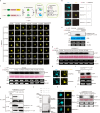Genetically-encoded targeted protein degradation technology to remove endogenous condensation-prone proteins and improve crop performance
- PMID: 39880812
- PMCID: PMC11779824
- DOI: 10.1038/s41467-025-56570-x
Genetically-encoded targeted protein degradation technology to remove endogenous condensation-prone proteins and improve crop performance
Abstract
Effective modulation of gene expression in plants is achievable through tools like CRISPR and RNA interference, yet methods for directly modifying endogenous proteins remain lacking. Here, we identify the E3 ubiquitin ligase E3TCD1 and develope a Targeted Condensation-prone-protein Degradation (TCD) strategy. The X-E3TCD1 fusion protein acts as a genetically engineered degrader, selectively targeting endogenous proteins prone to condensation. For example, a transgenic E3TCD1 fusion with Teosinte branched 1 (TB1) degrades the native TB1 protein, resulting in increased tiller numbers in rice. Additionally, conditional degradation of the negative defense regulator Early Flowering 3 via a pathogen-responsive ProTBF1-uORFsTBF1 cassette enhances rice blast resistance without affecting flowering time in the absence of pathogen. Unlike prevailing targeted protein degradation strategies, the TCD system does not rely on small molecules, antibodies, or genetic knock-in fusion tags, demonstrating its promise as a transgene-based approach for optimizing crop performance.
© 2025. The Author(s).
Conflict of interest statement
Competing interests: A patent with the application number 2024116014154 using all data generated from this study has been filed by Wuhan University, listing G.X., M.L., and Q.W. as inventors. Other authors claim no competing interests.
Figures






Similar articles
-
The Magnaporthe oryzae effector AvrPiz-t targets the RING E3 ubiquitin ligase APIP6 to suppress pathogen-associated molecular pattern-triggered immunity in rice.Plant Cell. 2012 Nov;24(11):4748-62. doi: 10.1105/tpc.112.105429. Epub 2012 Nov 30. Plant Cell. 2012. PMID: 23204406 Free PMC article.
-
The germin-like protein OsGLP2-1 enhances resistance to fungal blast and bacterial blight in rice.Plant Mol Biol. 2016 Nov;92(4-5):411-423. doi: 10.1007/s11103-016-0521-4. Epub 2016 Sep 15. Plant Mol Biol. 2016. PMID: 27631432
-
E3 ligase, the Oryza sativa salt-induced RING finger protein 4 (OsSIRP4), negatively regulates salt stress responses via degradation of the OsPEX11-1 protein.Plant Mol Biol. 2021 Feb;105(3):231-245. doi: 10.1007/s11103-020-01084-x. Epub 2020 Oct 20. Plant Mol Biol. 2021. PMID: 33079323
-
RNA interference in designing transgenic crops.GM Crops. 2010 Jul-Sep;1(4):207-13. doi: 10.4161/gmcr.1.4.13344. GM Crops. 2010. PMID: 21844675 Review.
-
Rice E3 ubiquitin ligases: From key modulators of host immunity to potential breeding applications.Plant Commun. 2024 Dec 9;5(12):101128. doi: 10.1016/j.xplc.2024.101128. Epub 2024 Sep 7. Plant Commun. 2024. PMID: 39245936 Free PMC article. Review.
References
-
- Liu, G., Lin, Q., Jin, S. & Gao, C. The CRISPR-Cas toolbox and gene editing technologies. Mol. Cell82, 333–347 (2022). - PubMed
-
- Cardi, T. et al. CRISPR/Cas-mediated plant genome editing: outstanding challenges a decade after implementation. Trends Plant Sci.28, 1144–1165 (2023). - PubMed
-
- Mou, R., Niu, R., Yang, R. & Xu, G. Engineering crop performance with upstream open reading frames. Trends Plant Sci.10.1016/j.tplants.2024.10.005 (2024). - PubMed
MeSH terms
Substances
LinkOut - more resources
Full Text Sources
Research Materials

